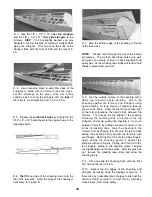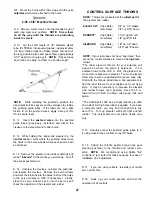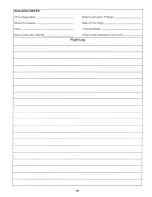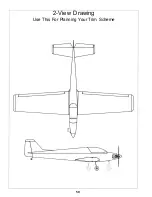
all the control surfaces do what they are supposed to.
The engine operation must also be checked and the
engine "broken in" on the ground by running the
engine for at least two tanks of fuel Follow the
engine manufacturer's recommendations for
break-in. Check to make sure all screws remain tight,
that the hinges are secure and that the prop is on
tight
RANGE CHECK YOUR RADIO
Wherever you fly, you need to check the
operation of the radio before every time you fly This
means with the transmitter antenna collapsed and the
receiver and transmitter on, you should be able to
walk at least 100 feet away from the model and still
have control Have someone help you Have them
stand by your model and, while you work the controls,
tell you what the various control surfaces are doing.
Repeat this test with the engine running at
various speeds with an assistant holding the model
If the control surfaces are not acting correctly at all
times, do not fly! Find and correct the problem first.
ENGINE SAFETY PRECAUTIONS
NOTE: Failure to follow these safety precautions
may result in severe injury to yourself and others.
•Keep all engine fuel in a safe place, away from high
heat, sparks or flames, as fuel is very flammable Do
not smoke near the engine or fuel, remember that the
engine exhaust gives off a great deal of deadly carbon
monoxide Therefore do not run the engine in a
closed room or garage
•Get help from an experienced pilot when learning to
operate engines.
•Use safety glasses when starting or running
engines.
•Do not run the engine in an area of loose gravel or
sand, as the propeller may throw such material in your
face or eyes.
•Keep your face and body as well as all spectators
away from the plane of rotation of the propeller as you
start and run the engine.
•Keep items such as these away from the prop loose
clothing, shirt sleeves, ties, scarfs, long hair or loose
objects (pencils, screw drivers) that may fall out of
shirt or jacket pockets into the prop.
•Use a "chicken stick" device or electric starter, follow
instructions supplied with the starter or stick Make
certain the glow plug clip or connector is secure so
that it will not pop off or otherwise get into the running
propeller.
•Use a low throttle setting when starting the engine.
•Make all engine adjustments from behind the rotating
propeller
•The engine gets hot' Do not touch it during or after
operation Make sure fuel lines are in good condition
so fuel is not leaked onto a hot engine causing a fire.
•To stop the engine, cut off the fuel supply by closing
off the fuel line or follow the engine manufacturer's
recommendations Do not use hands, fingers or any
body part to try to stop the engine Do not throw
anything into the prop of a running engine.
FLYING
The ULTRA SPORT 1000 is a great flying
sport airplane that flies smoothly and predictably, yet
is highly maneuverable It does not have the self-
recovery characteristics of a primary trainer, therefore
you must either have mastered the basics of R/C
flying or seek the assistance of a competent R/C pilot
to help you with your first flights
TAKEOFF: If you have dual rates on your transmitter,
set the switches to "high rate" for takeoff, especially
when taking off in a crosswind Although the ULTRA
SPORT 1000 has great low speed characteristics, you
should always build up as much speed as your runway
will permit before lifting off, as this will give you a
safety margin in case of a "flame-out" If you have
built a tricycle gear configuration and the ground
handling seems too quick and "squirrely," this can be
easily fixed by reducing the amount of nose gear
steering throw.
FLYING: We recommend that you take it easy with
your ULTRA SPORT 1000 for the first several flights
and gradually "get acquainted" with this fantastic ship
as your engine gets fully broken-in Add and practice
one maneuver at a time, learning how she behaves in
each one For ultra-smooth f l y i n g and normal
maneuvers, we recommend using the "low rate"
settings as listed on page 47 "High rate" elevator and
rudder will be required for snap rolls and spins Try
your first spins with elevator and rudder only, bringing
the nose up to full stall before applying rudder If you
notice any "sluggishness" in the way your ULTRA
SPORT 1000 handles, it is probably a result of not
enough speed, in which case you should install a
propeller with increased pitch Do not exceed the
recommended "high rate" throws for the rudder, as this
will only result in pitch-down when full rudder is
applied Speed is the key to good knife-edge
performance
52
Содержание Ultra-Sport 1000
Страница 7: ...7 DIE PATTERNS Use This Drawing To Identify Die Cut Parts...
Страница 57: ...57...
Страница 59: ...2 View Drawing Use This For Planning Your Trim Scheme 59...








































